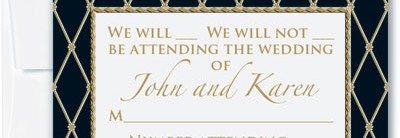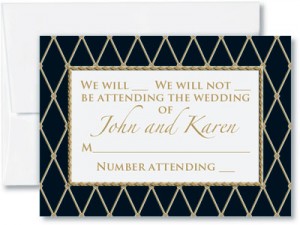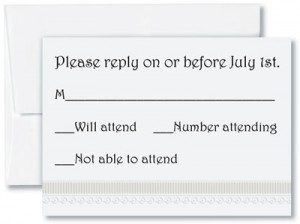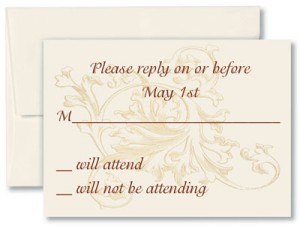Your wedding day is one of the most special and biggest celebrations of your life, and every detail counts—including your RSVP cards! Often overlooked, RSVP cards play a crucial role in ensuring your big day runs smoothly. Not only do they allow you to organize guest lists, catering, and seating arrangements, but they also set the tone for your wedding.
Whether you’re hosting a formal black-tie affair or a more laid-back garden celebration, your RSVP wording should reflect the theme and vibe of your wedding. This guide will walk you through best practices, creative ideas, and common mistakes to help you craft your response cards.
Why Wedding Response Cards Matter
You might know RSVP stands for the French phrase répondez s’il vous plaît, meaning “please respond,” but what makes these tiny cards such an essential piece of your wedding stationery?
The purpose of RSVP cards is to finalize your plans and ensure accuracy. RSVP cards eliminate guesswork and help you determine the exact number of attendees, making it easier to manage seating, catering, and wedding favors. By clearly indicating who will attend (and who won’t), response cards make it stress-free to plan for your guests’ needs.
RSVP cards also provide opportunities for your guests to share important information, like dietary restrictions or song requests. These personal touches ensure everyone feels cared for on your special day.
Understanding the Basics of RSVP Cards
At a minimum, every response card should include the following:
- Guest name(s) line (e.g., “M”)
- Acceptance/rejection options, like checkboxes or lines for guests to indicate whether they accept or decline the invitation.
- RSVP deadline, printed clearly to avoid confusion.
- Optional features can include meal selections, song requests, or space for special notes.
How to Encourage Guests to Respond
Getting guests to RSVP promptly is easier said than done. To make it simple (and fun) for your friends and family, consider these strategies:
- Include an SASE or online RSVP link: Remove barriers by pre-stamping an envelope or providing a QR code that leads directly to your RSVP page.
- Keep instructions clear: Use bold text to highlight your deadline or RSVP method.
- Digital RSVPs are increasingly in popularity among modern couples because they are quick and eco-friendly. Services like Zola and Minted even allow for customizable online RSVP trackers.
- Use light humor or urgency: Phrasing like “We can’t wait to celebrate with you! Kindly RSVP by [date]” feels friendly yet direct.
Matching RSVP Wording to Your Wedding Invitation Style
Your RSVP card should mirror the tone and design of your wedding invitations. A cohesive design reflects your attention to detail and sets the right expectations for your event. Be sure to maintain consistency by matching fonts, paper quality, and color palettes across your stationery suite.
Formal Weddings: Use timeless phrasing that aligns with an elegant aesthetic.
– “The favor of a reply is requested by [date].”
– “M”
– “Accepts with pleasure / Declines with regret.”
Casual Weddings: Incorporate playful or unique wording to match a relaxed theme.
– “Can’t wait to party! / Sorry to miss the fun.”
– “Happily attending / Regretfully declining.”
Highlighting the RSVP Deadline
A polite yet firm deadline is essential to avoid late responses. The general rule of thumb is to set the RSVP deadline at least 3–4 weeks before the wedding. This provides enough time to finalize guest lists and relay counts to your caterers. Avoid vague phrases like “ASAP,” as they fail to provide the necessary urgency. For Formal RSVP cards use “Kindly respond by September 15.” Casual RSVPs can be written as, “Please RSVP no later than Sept. 15! Don’t leave us hanging!”
Additional Information You Can Include
If certain details don’t fit in your wedding invitations, RSVP cards are a great place to provide additional information. Consider including “Plus-one confirmation,” Meal Options, Song Requests to help shape your reception playlist, or Accommodation or Travel Information (especially for destination weddings).
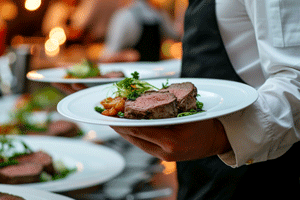
Adding Meal Choices on RSVP Cards
For weddings offering multiple entrees, it’s important to include a line for meal selections. Be respectful of dietary needs by clearly labeling each option. For example, “Please initial your entrée selection: Beef, Chicken, Vegetarian.” This small touch simplifies your catering planning and ensures every guest is accommodated.
Avoiding Common RSVP Wording Mistakes
To ensure your cards are effective and easy to use, steer clear of these common pitfalls:
- Unclear deadlines: Specify a precise date.
- Cluttered design: Leave ample spacing between text and avoid hard-to-read fonts.
- Forgetting postage: Always include a pre-stamped envelope for mail-in RSVPs.
- Overly complex wording: Keep your language straightforward to prevent confusion.
Create Your Own Response Cards with Ease
Crafting your own RSVP cards doesn’t have to be complicated! Many couples opt for DIY kits or templates on platforms like Canva or Adobe. These tools make it simple to customize everything from wording to design, ensuring your response cards perfectly match your vision.
If you prefer a more personal touch, consider ordering matching blanks and envelopes to align with your wedding suite. Not only does this save time, but it also ensures consistency across your invites.
Design RSVPs That Set the Tone for Your Big Day
Your RSVP cards are more than just a logistical tool; they’re an extension of your love story and the vibe of your wedding day. Whether you choose elegant, traditional wording or opt for a touch of whimsy, a thoughtfully designed RSVP card ensures smooth planning and a delightful guest experience.
Want to explore design ideas or find templates that fit your style? Browse our collection of customizable RSVP and invitation sets. You’ll find beautiful options that make your planning process as easy as saying “I do!”our one-stop online shopping source for DIY wedding supplies.
